Summer Student Projects 2009
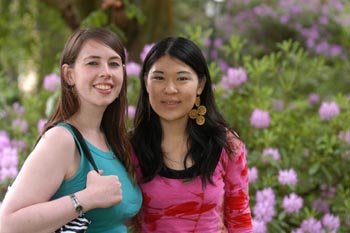 The following list will give some idea of the range and diversity of previous Summer Studentship Scheme projects, along with the named individuals who participated.
The following list will give some idea of the range and diversity of previous Summer Studentship Scheme projects, along with the named individuals who participated.
Design and integration of silicon sensor probing system
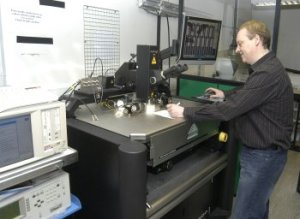 The Glasgow PPE group is currently using the 300 mm
automatic probe station for evaluation of prototypes of novel sensor
technologies and for quality assurance of nano-fabricated devices. This
activity is expected to increase with involvement in prototype testing for
ATLAS and LHCb upgrades and eventually production testing of those
upgrades.
The Glasgow PPE group is currently using the 300 mm
automatic probe station for evaluation of prototypes of novel sensor
technologies and for quality assurance of nano-fabricated devices. This
activity is expected to increase with involvement in prototype testing for
ATLAS and LHCb upgrades and eventually production testing of those
upgrades.
The proposed project consists of fully integrating control and data-taking
of the laboratory instruments required for the measurements, together
with the control of the automatic prober itself. The aim is to achieve a
ready-to-use system that can perform the standard characterisation
measurements of silicon sensors according to the agreed procedures. The
data from the measurements together with environmental information should
be stored in a standard data format.
The project will involve minor electrical and mechanical design to achieve
required electrical connectivity and decoupling between instruments.
Furthermore it requires programming in LabView or similar to control the instruments and probe station and to record the data. The project might
also include the first stage of online data analysis for one or two
standard measurements.
Supervisors: Lars Eklund (Richard Bates 2nd)
Back-up Supervisor: Val O'Shea
Student: Malcolm Skinner
Project Duration: 6 weeks (from ~June 1st)
A Retinal Prosthesis for the Blind
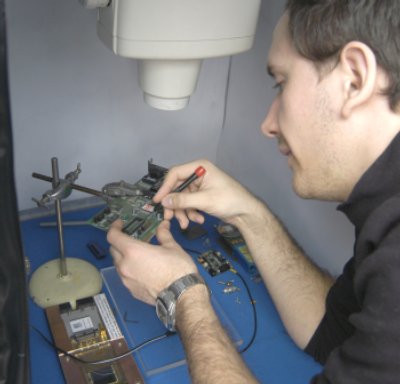 The major cause of human blindness in the developed world arises as a result of degeneration of the retina. Given that a substantial proportion of post-receptoral neurons in the retina are known to survive, there is the possibility of restoring spatial vision through electrical stimulation of the retinal output (ganglion) cells with multi-electrode arrays coupled to an imaging device.
The major cause of human blindness in the developed world arises as a result of degeneration of the retina. Given that a substantial proportion of post-receptoral neurons in the retina are known to survive, there is the possibility of restoring spatial vision through electrical stimulation of the retinal output (ganglion) cells with multi-electrode arrays coupled to an imaging device.
Aims:
- To characterise the output stimulation pulses for the 2nd generation retinal stimulation chip. The student will become familiar with LabView software and how it can be used to control scientific instruments.
- To investigate the suitability of nanofabricated platinum microelectrodes to stimulate retinal cells without loss of electrical properties. A key aspect of a viable retinal prosthesis is to be able to pack many electrodes at a high density. This has the potential to create many independent stimulation sites and so allow a detailed image to be created in the visual system of a blind patient. The student will be involved in using impedance spectroscopy and cyclic voltammetery to analyse the performance of these microelectrodes.
- To analyse data recorded from this system in experiments to stimulate retinal tissue to ascertain the following:
- Whether these small electrodes can elicit the appropriate response from a single retinal ganglion cell or whether groups of cells are stimulated
- Determine the threshold activation charge needed to depolarize the RGCs
- Examine whether this threshold activation charge is sufficient to damage the microelectrode or whether the charge required is below the charge capacity of the electrode
Supervisor: Keith Mathieson
Back-up Supervisor: J D Morrison
Student: Iain James Hugh McCrindle
Project Duration: 6 weeks (from ~June 1st)
3D detector systems for the ATLAS upgrade
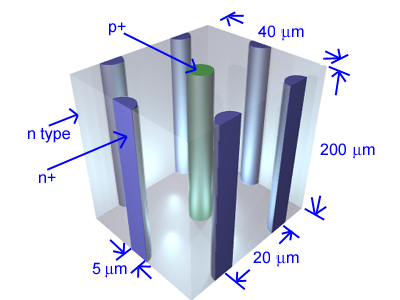 The most exciting and technologically demanding sub-detector of the ATLAS experiment (http://www.atlas.ch/) is the silicon pixel detector. For the upgrade of the ATLAS experiment to work at the super-high luminosity LHC (sLHC) the pixel detector will require significant development. The main demand imposed by sLHC is the increase of an order of magnitude in the radiation dose experienced by the detectors.
The most exciting and technologically demanding sub-detector of the ATLAS experiment (http://www.atlas.ch/) is the silicon pixel detector. For the upgrade of the ATLAS experiment to work at the super-high luminosity LHC (sLHC) the pixel detector will require significant development. The main demand imposed by sLHC is the increase of an order of magnitude in the radiation dose experienced by the detectors.
The silicon sensor work at Glasgow is focused on the 3D silicon sensor technology. This device couples the latest in silicon detector and silicon micro-machining technology resulting in a new detector design. The 3D device exhibits fast charge collection and ultra radiation hard properties.
The aim of this project is to test the first 3D detectors produced by our collaborators at the Centro Nacional de Microelectronica (CNM), Barcelona.
The 3D detectors will be tested with LHC readout electronics to allow the collection of charge in a similar fashion as in the ATLAS Pixel detector. 3D sensors have been irradiated at different doses up to the full doses expected for operation of the ATLAS pixel detector. These will be tested in the
laboratory to understand the charge collection as a function of radiation dose for 3D detectors.
These results will be an important contribution to the discussion in the ATLAS collaboration for the use of 3D detectors in the ATLAS pixel experiment.
Supervisor: Richard Bates
Back-up Supervisor: Chris Parkes
Student: Xavier Blot
Project Duration: 6 weeks (from ~June 1st)
ATLAS data analysis project
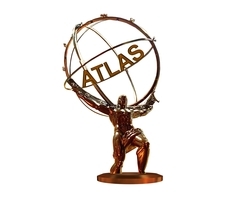 When the LHC starts proton collisions in October 2009, we will be involved in measuring the cross section for top-antitop production at ATLAS.
When the LHC starts proton collisions in October 2009, we will be involved in measuring the cross section for top-antitop production at ATLAS.
Measurements of this process will improve our understanding of QCD, and prepare us for higgs boson searches in the ttH channel. We have a particular interest in top quark pair production with extra jets.
In this project you will investigate different jet definitions in simulated top-antitop events to help us improve our analysis. You will work with us on improving our fast detector simulation using this process as a test.
Supervisor: Sarah Allwood-Spiers
Back-up Supervisor: Craig Buttar
Student: Graeme Darroch
Project Duration: 6 weeks (from ~June 1st)
Higgs data analysis projects
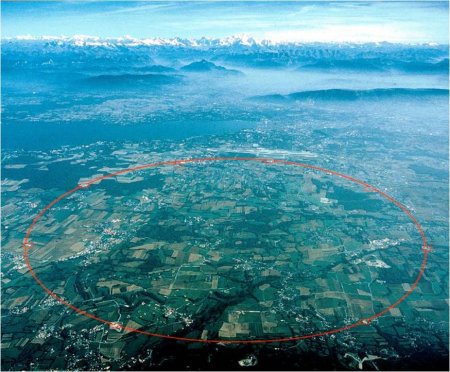 Analysis to obtain better acceptance for the Higgs and reach single experiment sensitivity for the Summer 2009 conferences. This work would involve one or more of the following lines of study: (3 separate projects as follows):
Analysis to obtain better acceptance for the Higgs and reach single experiment sensitivity for the Summer 2009 conferences. This work would involve one or more of the following lines of study: (3 separate projects as follows):
- To train neural nets specifically for the vector boson mode of production, contributing mainly to the limits at 160 GeV where exclusion with both CDF and D0 is obtained but not for CDF alone.
- To examine the self-spoiling of the recognition of the two charged leptons produced in H->WW. The leptons are produced parallel to one another due to the spin of the Higgs and maximal parity violation in the W (weak) decay. This is the most discriminant part of the phase space and also is cut out by the lepton isolation used in identifying the leptons. The fraction of events in this region needs investigation and if significant some adjustment of the isolation requirement could be done to gain much more than just the acceptance since the uniqueness of the signal is very noticeable.
- To produce a measurement of ZZ production with one Z decay to charged leptons and the other to neutrinos. This is a candle with an event rate only about three times that of the Higgs and provides a very important validation of the multivariate techniques. This may be relatively simple to do with the the analysis already in place and could lead to a paper.
Supervisors: Rick St. Denis and Aidan Robson
Student: Brian Colquhoun
Project Duration: May 25 to July 3 (there is no flexibility in this)
An ATLAS inclusive Higgs search
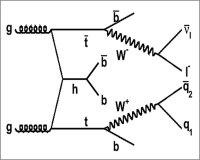 The Glasgow ATLAS group is involved in searching for the Higgs boson using the ATLAS detector at the LHC using an inclusive search based upon a lepton trigger and Higgs boson decay to b+bbar. This project will aim to set up and document the Neural Network and fitting software used to separate signal from background and also provide exclusion limits based on anticipated luminosity gathered from collisions at the LHC.
The Glasgow ATLAS group is involved in searching for the Higgs boson using the ATLAS detector at the LHC using an inclusive search based upon a lepton trigger and Higgs boson decay to b+bbar. This project will aim to set up and document the Neural Network and fitting software used to separate signal from background and also provide exclusion limits based on anticipated luminosity gathered from collisions at the LHC.
Supervisor: Chris Collins-Tooth
Back-up Supervisor: Tony Doyle
Student: Gavin Kirby
Project Duration: 6 weeks (from ~June 1st)
Active Pixel Sensors
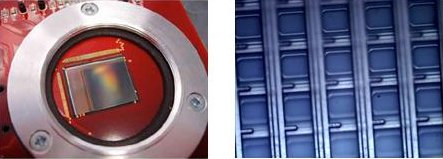 For many years CCDs have been the imaging detector of choice for many commercial, industrial and scientific applications (digital cameras, CCTV technology, spaced based imaging etc). However, in the past 10 years active pixel sensors - APS - have emerged as a viable alternative to CCDs. Using CMOS technology, APS detectors can now be custom made to include specialised electronics to fit the desired application. This has led to interest in both the medical physics and particle physics field.
For many years CCDs have been the imaging detector of choice for many commercial, industrial and scientific applications (digital cameras, CCTV technology, spaced based imaging etc). However, in the past 10 years active pixel sensors - APS - have emerged as a viable alternative to CCDs. Using CMOS technology, APS detectors can now be custom made to include specialised electronics to fit the desired application. This has led to interest in both the medical physics and particle physics field.
In this work you will have the opportunity to test, characterise and use a range of APS devices. This will involve testing their spectral response to visible light, measuring noise levels and comparing them to commercially available CCDs.
This project would be ideally suited to anyone wanting hands-on experience with lab equipment, control software (Labview), and to anyone with an interest in imaging detectors.
Supervisor:
Andrew Blue
Back-up Supervisor: Val O'Shea
Student: Sian Nutbeam
Project Duration: 6 weeks (from ~June 1)

